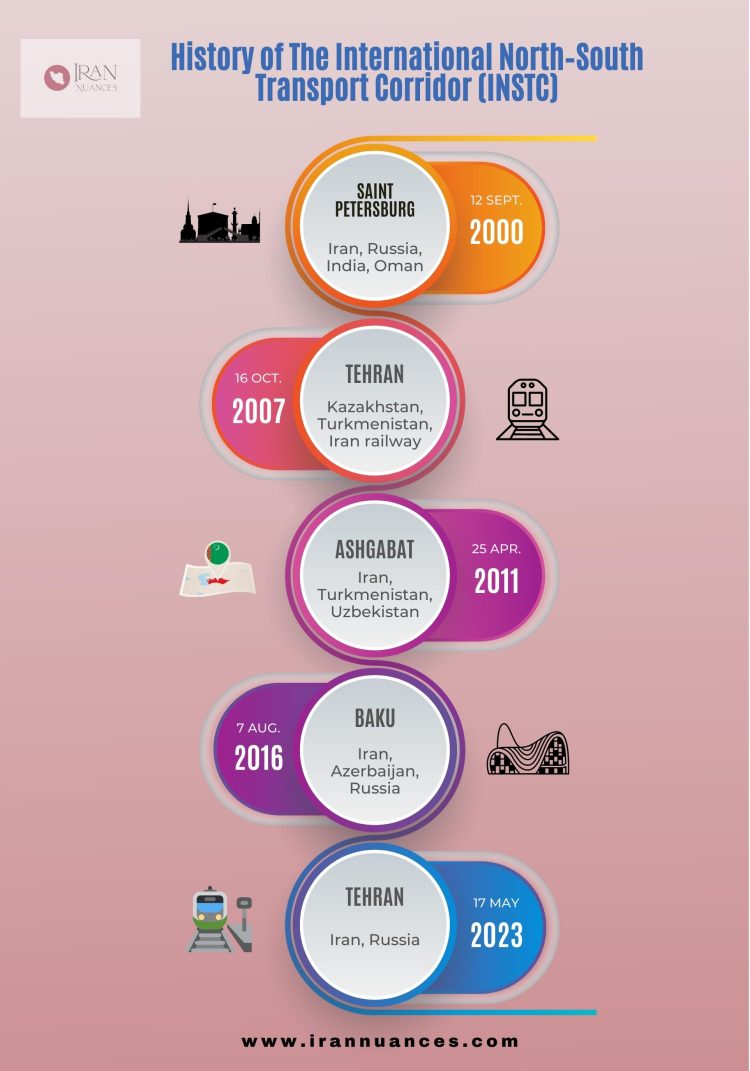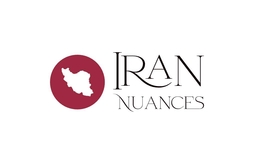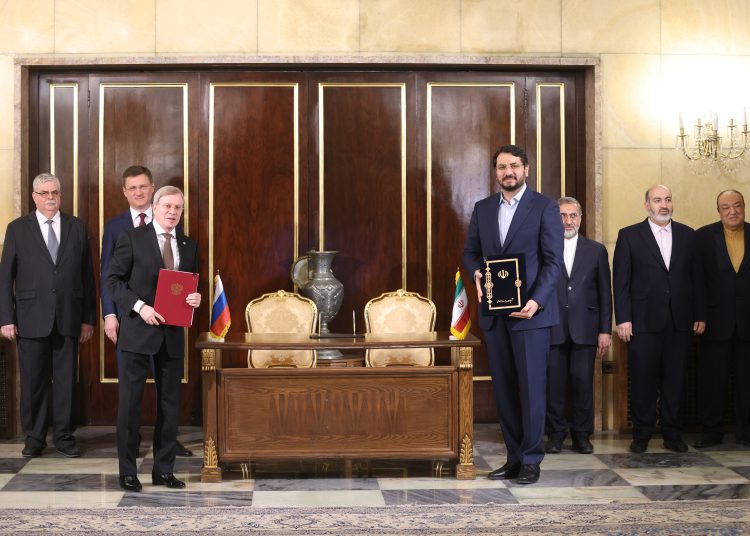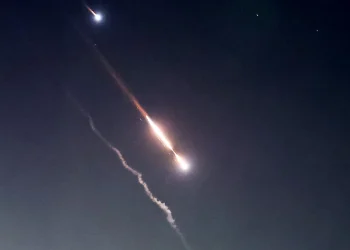As the geopolitical and geo-economic landscape shifts, the North-South Corridor attracts regional and extra-regional powers but faces challenges from China and the US rivalry and regional and international uncertainties.
By Afifeh Abedi
As the geopolitical and geo-economic landscape shifts, the North-South Corridor garners significant attention from regional and extra-regional powers due to its role in fostering regional interdependence. The corridor holds immense importance for Iran, Russia, and India, as Russia seeks to strengthen economic ties with the East, particularly the vast market of India, in response to Western sanctions. Concurrently, India pursues the most accessible and cost-effective route to the markets of West Asia, Central Asia, South Caucasus, and Eastern Europe. Iran’s strategic geopolitical and geo-economic position plays a crucial role in the corridor, as its location facilitates rail-road connections and access to the extensive coastlines of the Persian Gulf, the Makran Sea, and the Indian Ocean.
However, the North-South Corridor presents challenges for China and the United States, who engaged in fierce competition for geopolitical influence. Despite its potential for organic growth, the corridor faces uncertainties due to regional and international factors.
Grounds for organic growth of the North-South Corridor
The first agreement on the International North-South Transport Corridor (INSTC) was signed in 2000 in St. Petersburg by the Ministers of Transport of Iran, India, and Russia. Before China’s Belt and Road Initiative in 2013, the North-South Corridor served as the principal trade link between Asia and Europe.
Initially conceived to connect Eastern Europe with Southeast Asia, the corridor was to utilize the capacity of the Caspian Sea and Iran’s rail-road and sea lines. In 2014, Turkmenistan and Kazakhstan connected to Iran’s railway, which, along with Russia, became part of the North-South Corridor. Subsequently, a 2016 tripartite agreement between Iran, Russia, and Azerbaijan in Baku added the western route to the corridor.
The North-South Corridor’s potential for organic growth has attracted a significant number of countries to join its ranks in recent years. Oman, Turkmenistan, Uzbekistan, and Kazakhstan are among the partners of the North-South Corridor. Armenia, Georgia, Turkey, and the United Arab Emirates also have the potential to join the corridor. The corridor’s primary objective was to provide India access to Europe via Iran and Russia. Its shorter route, nearly 60% less than the Suez Canal sea route, significantly reduces shipping time from India to Northern Europe.
Observers and stakeholders have increasingly focused on the corridor’s capacity to connect to India’s vast market. The North-South Corridor holds strategic importance for Russia, Central Asian Republics, and Iran in terms of access to Southeast Asia. Furthermore, the corridor could serve as vital infrastructure in promoting intra-institutional trade and development within the Shanghai Cooperation Organization (SCO), the Eurasian Union, and the concept of Greater Eurasia.
While the North-South Corridor maintains the potential to establish a geo-economic link between Europe and Asia, its possible connections to Eastern Europe and potential partnerships with countries such as Turkey, Ukraine, and Bulgaria merit consideration.

Uncertainties facing the corridor
Political challenges between some member states and international powers present significant obstacles to the North-South Corridor. Since 2020, political and military tensions between Azerbaijan and Armenia have cast a shadow on relations between Tehran and Baku, affecting the corridor’s western route. However, the potential inclusion of Armenia and Georgia in the North-South Corridor has been raised. Meanwhile, the Central Asian Turani Corridor, originating in Turkey, is also seen as a competitor to the North-South Corridor.
The positions of the United States and China concerning the North-South Corridor also carry significant weight. The ongoing conflict in Ukraine and extensive sanctions against Russia, coupled with Iran’s stalled nuclear negotiations with the West, could potentially increase Western opposition to the corridor. Developing economic relations between Russia and the East may alleviate the pressure of Western sanctions on Russia. The Iran-Russia contract to complete the Astara-Rasht railway line faces uncertainty due to Western economic sanctions against both countries. Further imposition of sanctions and restriction of financial resources may alter the project’s priority status, resulting in additional delays in the completion of the railway. However, alternative transportation infrastructure in Iran may help overcome temporary challenges.
The competition between China and India could also impact the North-South Corridor and exacerbate the Chabahar-Gwadar rivalry. Iran and Russia must consider China’s concerns, as Iran aims to foster relations with China while playing a key role in the North-South Corridor to promote India’s interests against the Belt and Road Initiative. The Chabahar port in southeast Iran, a crucial station of the North-South Corridor, is considered strategically important for cost and time reduction.
Conversely, the strategic relationship between the United States and India along with India’s deepening ties with Europe, may negatively impact Russia-India relations and cooperation in the North-South Corridor. The ambitious American initiative to connect India to the Persian Gulf and the United States through the I2U2 format could potentially diminish the importance of the Belt and Road Initiative and the North-South Corridor.
India demonstrates a complex and nuanced policy towards Russia and the West, as it refrains from compliance with Western sanctions against Russia. Russian president Vladimir Putin contends that Russo-Indian relations embody a privileged strategic partnership. Yet, India cannot forgo its relationship with the United States in its competition against China. Concurrently, a strategic alliance between China and Russia emerges as a potential scenario in the East-West rivalry.
Prospects of the corridor
Despite numerous political contests, the North-South Corridor possesses the capacity for growth and expansion. This passage can connect South and Southwest Asia to the Eurasian region, Eastern and Northern European countries, linking the Caspian Sea to the Indian Ocean and the Persian Gulf to the Black Sea. Simultaneously, an increased interest in intra-regional trade may further incentivize other countries to connect to this corridor, leading to bilateral, multilateral, or regional tariff agreements. Nevertheless, political uncertainties cannot be disregarded, as the emerging geopolitical competition among powers could hinder the organic growth of the North-South Corridor. However, if Russia fulfills its commitment to constructing the Astara-Rasht railway line, the corridor may be able to surmount some political uncertainties and maintain its trajectory.
The views expressed in this article are those of the author and do not necessarily reflect the positions of Iran Nuances.







Because the site’s administrator is actively working, it will undoubtedly become well-known very rapidly as a result of its high-quality materials.